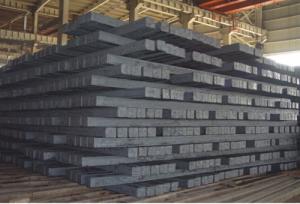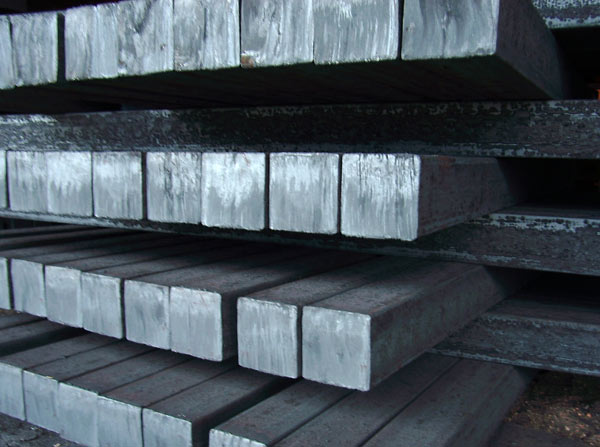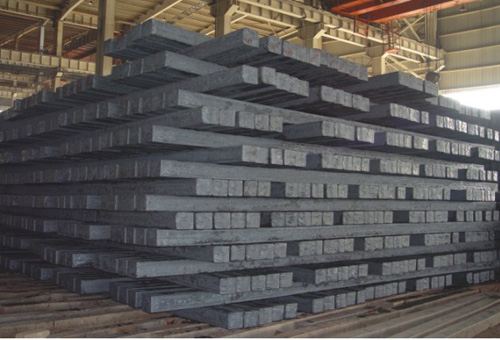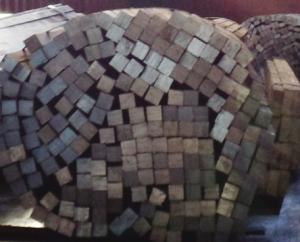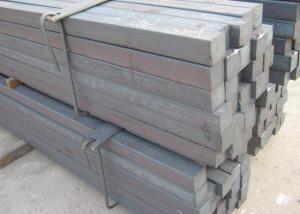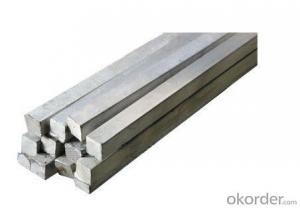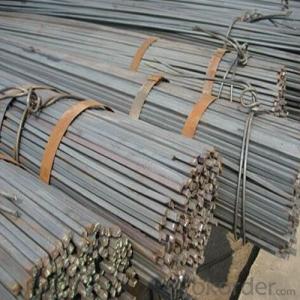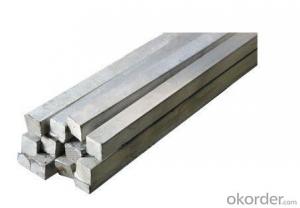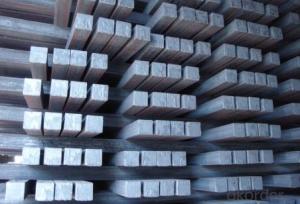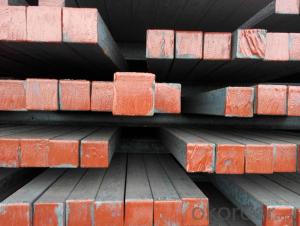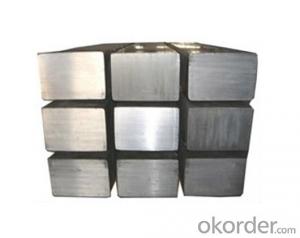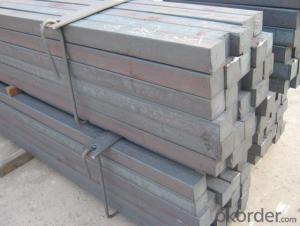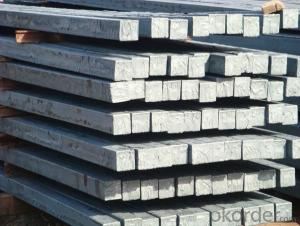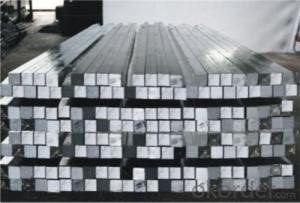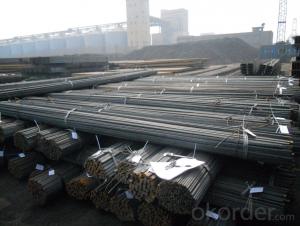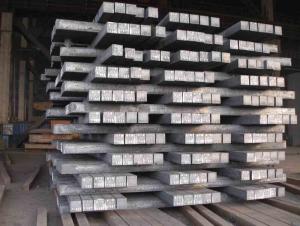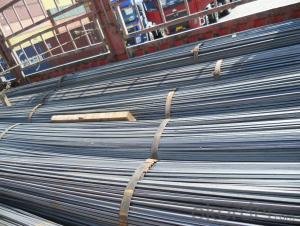Q195 Square bar square bar for construction
- Loading Port:
- Shanghai
- Payment Terms:
- TT or LC
- Min Order Qty:
- 10000 m.t.
- Supply Capability:
- 100000 m.t./month
OKorder Service Pledge
OKorder Financial Service
You Might Also Like
Product Description:
OKorder is offering Q195 Square Bar square Bar for construction at great prices with worldwide shipping. Our supplier is a world-class manufacturer of steel, with our products utilized the world over. OKorder annually supplies products to European, North American and Asian markets. We provide quotations within 24 hours of receiving an inquiry and guarantee competitive prices.
Product Applications:
Q195 Square Bar square Bar for construction are ideal for structural applications and are widely used in the construction of buildings and bridges, and the manufacturing, petrochemical, and transportation industries.
Product Advantages:
OKorder's Square Bar are durable, strong, and resist corrosion.
Main Product Features:
· Premium quality
· Prompt delivery & seaworthy packing (30 days after receiving deposit)
· Corrosion resistance
· Can be recycled and reused
· Mill test certification
· Professional Service
· Competitive pricing
Product Specifications:
We offer Square Steel Bar with grade Q195 / Q235
Specifications of Square Steel Bar:
-Standard: GB,
-Grade: Q195/Q235 or equivalent.
Chemical Composition:
-Chemical Composition. Q195
Standard | Grade | Element (%) | ||||
GB | Q195 | C | Mn | S | P | Si |
0.06~0.12 | 0.25~0.50 | ≤0.050 | ≤0.045 | ≤0.30 | ||
-Chemical Composition. Q235
Standard | Grade | Element (%) | ||||
GB | Q235B | C | Mn | S | P | Si |
0.12~0.20 | 0.30~0.70 | ≤0.045 | ≤0.045 | ≤0.30 | ||
Measures and Tolerances of Square Steel Bar:
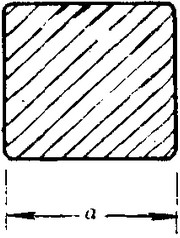
(The section of Square Steel Bar)
-The length of a side and the theoretical weight of Square Steel.
Length of a side(a, mm) | Theoretical weight(kg/m) | Length of a side(a, mm) | Theoretical weight(kg/m) |
6 | 0.283 | 32 | 8.04 |
7 | 0.385 | *33 | 8.55 |
8 | 0.502 | 34 | 9.07 |
9 | 0.636 | *35 | 9.62 |
10 | 0.785 | 36 | 10.17 |
11 | 0.950 | 38 | 11.24 |
12 | 1.13 | 40 | 12.56 |
13 | 1.33 | 42 | 13.85 |
14 | 1.54 | 45 | 15.90 |
15 | 1.77 | 48 | 18.09 |
16 | 2.01 | 50 | 19.63 |
17 | 2.27 | 53 | 22.05 |
18 | 2.54 | *55 | 23.6 |
19 | 2.82 | 56 | 24.61 |
20 | 3.14 | *58 | 26.4 |
21 | 3.46 | 60 | 28.26 |
22 | 3.80 | 63 | 31.16 |
*23 | 4.15 | *65 | 33.17 |
24 | 4.52 | *68 | 36.3 |
25 | 4.91 | 79 | 38.49 |
26 | 5.30 | 75 | 44.16 |
*27 | 5.72 | 80 | 50.24 |
28 | 6.15 | 85 | 56.72 |
*29 | 6.60 | 90 | 63.59 |
30 | 7.06 | 95 | 70.85 |
*31 | 7.54 | 100 | 78.50 |
Notes:
1, The theoretical weights in the list, base on the density of 7.85 g/cm3.
2, The numbers with *mean that they are not regulars or we don’t offer them.
-The allowed tolerance of Square Steel:
Length of a side(mm) | Allowed Tolerance | ||
Group1 | Group2 | Group3 | |
5.5~7 | ±0.20 | ±0.30 | ±0.40 |
7~20 | ±0.25 | ±0.35 | ±0.40 |
20~30 | ±0.30 | ±0.40 | ±0.50 |
30~50 | ±0.40 | ±0.50 | ±0.60 |
60~80 | ±0.60 | ±0.70 | ±0.80 |
80~110 | ±0.90 | ±1.0 | ±1.1 |
110~150 | ±1.2 | ±1.3 | ±1.1 |
150~190 | ―― | ―― | ±2.0 |
190~250 | ―― | ―― | ±2.5 |
Usage/Applications of Steel Square Bar:
-The Square Steel is normally used as structure steel.
-Row material for other structure steel like steel angles, channels, I-beams, H-beams, etc…
Packaging & Delivery of Steel Square Bar:
-Packing Detail: The products can be packed in bundles by steel wires.
-Marks:
1, Tag marks: the tag marks will be tied up to each bundle of the products. The information is usually including supplier’s logo and name, product name, made in China, products’ specifications, the painted color and other information requested by customers.
2, Color marks: we will paint both ends of the bundles of these products to make sure that they are more evident. It’s will be more convenient for the customers to distinguish them at the destination port.
-Delivery Detail: 30~45 working days after receive buyer’s T.T. or L/C.
FAQ:
Q1: What makes stainless steel stainless?
A1: Stainless steel must contain at least 10.5 % chromium. It is this element that reacts with the oxygen in the air to form a complex chrome-oxide surface layer that is invisible but strong enough to prevent further oxygen from "staining" (rusting) the surface. Higher levels of chromium and the addition of other alloying elements such as nickel and molybdenum enhance this surface layer and improve the corrosion resistance of the stainless material.
Q2: Can stainless steel rust?
A2: Stainless does not "rust" as you think of regular steel rusting with a red oxide on the surface that flakes off. If you see red rust it is probably due to some iron particles that have contaminated the surface of the stainless steel and it is these iron particles that are rusting. Look at the source of the rusting and see if you can remove it from the surface.
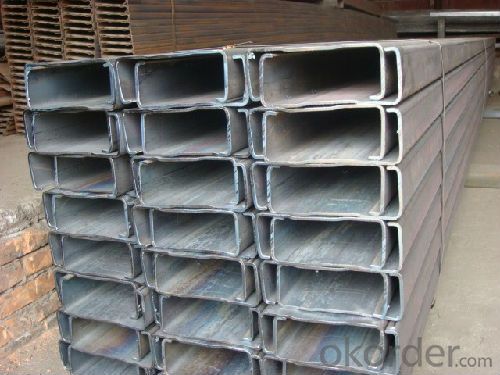
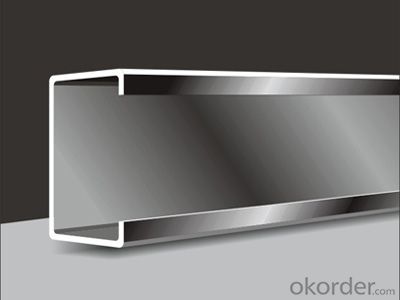
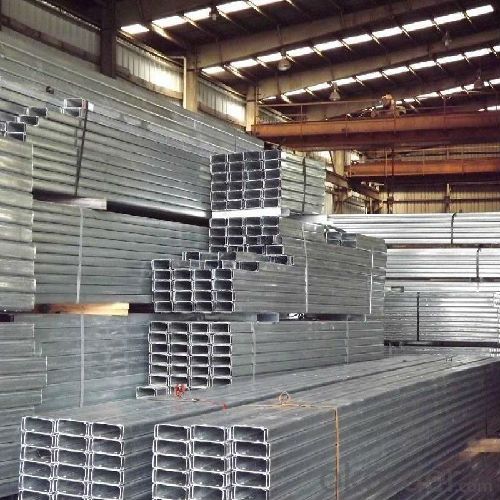
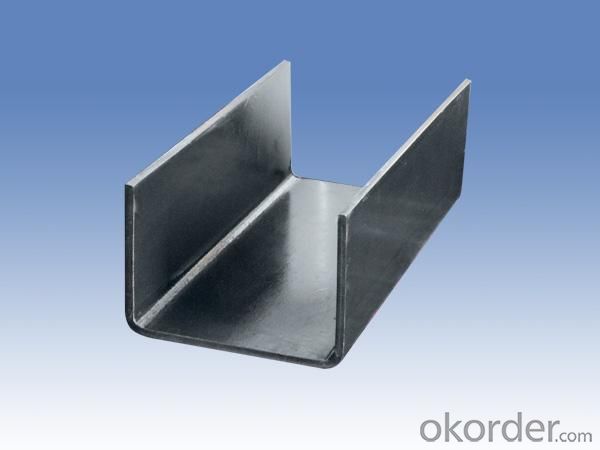
- Q: How do you use a steel square to lay out a diagonal line?
- To use a steel square to lay out a diagonal line, you place the square with one leg along the edge of the material and the other leg at a 45-degree angle. Then, you mark the desired length of the diagonal line along the 45-degree leg and draw a line connecting the mark to the edge of the material.
- Q: How do you use a steel square to create half-lap joints?
- To create half-lap joints using a steel square, first, mark the centerline on both pieces of wood that will be joined. Then, position the steel square on one piece of wood, aligning the centerline with the edge of the square. Use a pencil to mark the width of the half-lap joint on the wood. Repeat this step on the other piece of wood. Next, use a saw to cut along the marked lines, ensuring the cuts are straight and parallel to the edge of the wood. Finally, fit the two pieces of wood together, ensuring the half-lap joints align perfectly, and secure them with glue or screws to complete the joint.
- Q: How do you use a steel square to check for plumbness in a wall?
- To check if a wall is plumb, you can follow these steps using a steel square: 1. Begin by choosing a steel square, which is a measuring tool with a 90-degree angle. It consists of a long blade and a shorter tongue that is perpendicular to the blade. 2. Stand beside the wall that you want to check for plumbness. Hold the steel square so that the blade is vertical and the tongue is horizontal, with the tongue touching the wall. 3. Position the blade of the steel square against the wall, ensuring it is flush with the surface. 4. Examine the space between the tongue and the wall. If the wall is plumb, there should be no gap. A gap suggests that the wall is not perfectly vertical. 5. To determine the extent of plumbness, you can use a level on the tongue of the steel square. Place the level on the top of the tongue and adjust it until it indicates a completely vertical position. This will help you identify the exact angle of deviation from plumbness. 6. Repeat this process at different points along the wall to ensure consistency. Checking at multiple locations is crucial to confirm that the entire wall is plumb. By utilizing a steel square, you can conveniently and accurately assess the plumbness of a wall. This is especially valuable when undertaking construction or carpentry projects that demand precise alignment and verticality.
- Q: The difference between galvanized square and galvanized steel
- There is a difference in the quality of classification and can be processed into cold and hot dip galvanized pipe, galvanized pipe, galvanized pipe and galvanized belt can not be made, because of its wall thickness is thin, so the price will take the price dip galvanized pipe is much higher than galvanized pipe.
- Q: Can a steel square be used for measuring roof pitch?
- Yes, a steel square can be used for measuring roof pitch. A steel square, also known as a framing square or carpenter's square, is a versatile tool used in carpentry and construction. It has a long blade and a shorter tongue, forming an L-shape. The blade of the square is marked with various angles and measurements, making it useful for determining roof pitch. To measure the roof pitch using a steel square, you can place the longer blade of the square along the roof rafters or trusses, ensuring that it is aligned with the bottom edge of the roof. Then, you can adjust the angle of the square until the shorter tongue rests on the roof surface. By reading the measurement on the blade where it intersects the desired pitch, you can determine the roof pitch accurately. The steel square's ability to measure angles and pitch makes it a reliable tool for determining roof slope and ensuring proper installation of roofing materials. However, it is essential to note that using a steel square may require some knowledge and practice to obtain accurate measurements. Additionally, other specialized tools, such as a digital inclinometer or a laser level, may provide more precise measurements for roof pitch in certain circumstances.
- Q: Can a steel square be used for checking the squareness of a deck frame?
- Yes, a steel square can be used for checking the squareness of a deck frame. A steel square, also known as a framing square or carpenter's square, is a versatile tool commonly used in carpentry and construction. It consists of two perpendicular arms, one long and one shorter, forming a right angle. To check the squareness of a deck frame using a steel square, you can follow these steps: 1. Place the longer arm of the steel square against the edge of the deck frame, ensuring it is flush. 2. Extend the shorter arm of the steel square along the adjacent edge of the frame. 3. Look for any gaps or inconsistencies between the frame and the steel square. If the frame is perfectly square, the steel square should align perfectly with the edges of the frame. 4. If there are gaps or misalignments, adjust the frame by tapping or pushing it until it is square. 5. Repeat the process on all corners of the deck frame to ensure overall squareness. Using a steel square is an effective and reliable method for checking the squareness of a deck frame. It provides a visual reference to ensure the frame is square, which is essential for proper installation and structural integrity.
- Q: Can a steel square be used for gazebo post layout and installation?
- Yes, a steel square can be used for gazebo post layout and installation. A steel square, also known as a framing square or a carpenter's square, is a versatile tool commonly used in construction and woodworking. It consists of a long blade and a shorter tongue that meet at a 90-degree angle, allowing for accurate measurements and layout. When it comes to gazebo post layout and installation, a steel square can be a valuable tool. It can assist in determining the correct angles and measurements for positioning the posts, ensuring that they are level and aligned properly. To use a steel square for gazebo post layout, you can use it to mark out the corners and angles where the posts should be placed. By aligning the blade or the tongue of the square with the edges of the gazebo base or the desired position of the posts, you can ensure accurate measurements and angles. During installation, a steel square can also be handy for checking that the posts are plumb and level. By placing the square against the sides of the posts, you can verify if they are perfectly vertical or if adjustments need to be made. In summary, a steel square can certainly be used for gazebo post layout and installation. Its versatility and accuracy make it a useful tool for ensuring that the posts are positioned correctly and are level.
- Q: Can a steel square be used for measuring curved surfaces?
- No, a steel square cannot be used for measuring curved surfaces as it is designed for measuring and marking right angles and straight lines.
- Q: How do you use a steel square to measure and mark out crosscuts?
- To measure and mark out crosscuts using a steel square, the following steps are typically followed: 1. Start by setting up your workpiece securely on a workbench or saw horses, ensuring it is clamped or held in place. 2. Measure and mark the desired length of the crosscut on the edge of the workpiece using a measuring tape or ruler. 3. Position the steel square against the edge of the workpiece, making sure the long arm touches the edge and the short arm extends over the face of the workpiece. 4. Align the square by adjusting its position until the long arm is parallel to the marked line on the edge of the workpiece. 5. Mark the exact location of the crosscut by using a pencil or sharp knife to draw a line along the edge of the steel square's short arm, extending across the face of the workpiece. 6. Ensure accuracy by double-checking your measurements before proceeding with the cut. If necessary, make any adjustments to the position of the steel square. 7. Finally, make the crosscut carefully using a suitable saw, such as a handsaw or circular saw. Remember to follow safety precautions and use the appropriate technique for the particular saw you are using. By following these steps, you can achieve precise and accurate crosscuts by effectively utilizing a steel square.
- Q: How do you use a steel square to lay out a jack rafter with unequal pitch?
- To lay out a jack rafter with unequal pitch using a steel square, you can follow the following procedure: 1. Begin by determining the pitch of the common rafter. This can be done by calculating the ratio of the rise to the run, often expressed as a fraction like 4/12 or 6/12. 2. Next, calculate the pitch of the jack rafter by multiplying the pitch of the common rafter with the run of the jack rafter. 3. Position the steel square on the edge of a board, ensuring that the tongue (shorter side) is facing upwards and the body (longer side) is resting against the side of the board. 4. Slide the square along the board until the edge of the tongue aligns with the run measurement of the jack rafter pitch calculated in step 2. 5. Securely hold the square against the board and use a pencil to mark the edge of the board along the body of the square. 6. Repeat steps 3 to 5 for the other side of the jack rafter, using the same pitch measurement. 7. Use a straightedge or a chalk line to connect the marks made in step 6. This line represents the plumb cut of the jack rafter. 8. Utilize a saw to cut along the line, following the angle determined by the steel square. By employing a steel square and adhering to these steps, you can effectively lay out a jack rafter with an unequal pitch. It is crucial to measure and mark with precision to ensure an accurate cut, as any inaccuracies can impact the overall structure and stability of the roof.
Send your message to us
Q195 Square bar square bar for construction
- Loading Port:
- Shanghai
- Payment Terms:
- TT or LC
- Min Order Qty:
- 10000 m.t.
- Supply Capability:
- 100000 m.t./month
OKorder Service Pledge
OKorder Financial Service
Similar products
Hot products
Hot Searches
Related keywords

